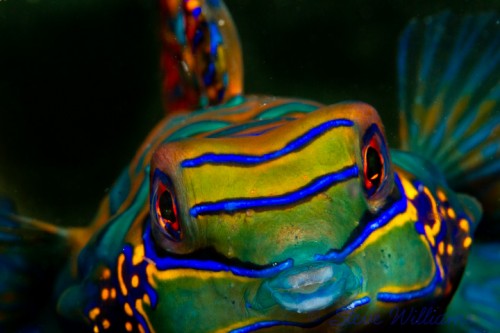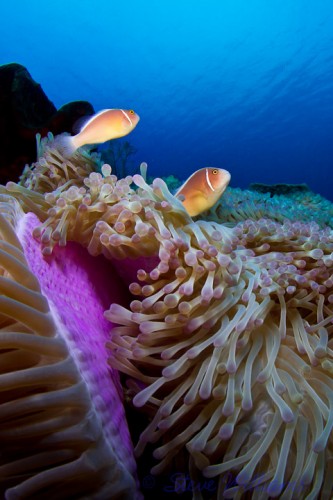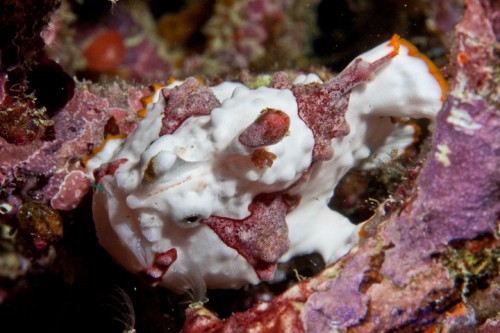Amazed and Alarmed: Chapter one

Regular Wetpixel contributor Steve Williams recently completed a diving trip from Komodo to Wakatobi on the boat M/Y Pelagian. What follows is his personal illustrated account of the trip, recounting both the beauty and the tribulations of an underwater photographic journey.( All images are the authors own.)
There are special moments underwater that fill up our soul and burn themselves into that special place in our brain reserved for unimagined memories. My latest came on the twenty eighth dive of our trip on the Pelagian from the Komodo Islands to the Wakatobi resort. We entered the water on our early morning dive at 7:00 am off the reef on the west side of tiny Kapota Island. Huge sea fans leaned out from the forty meter vertical coral walls as a light current drifted us along in the subdued blue. The largest sponges I have ever seen slanted into the current as thousands of small fish circled and danced around them and the soft corals of every color that covered the reef. The special magic that morning came from the light of the newly risen sun as it streamed in golden hues almost horizontally down the huge finger canyons that cut the walls. I looked down at the puny lens on my camera and realized there was no way I could come close to capturing the image before me. Sometimes you just have to put the camera down and soak up the view. These special places are my personal cathedrals. I will always remember that morning when the reef looked even more magical than I dreamed it could be.
There are many other memories from that trip that began in the dusty ramshackle harbor of Bima, Indonesia where we boarded the dive yacht Pelagian for a twelve day ride through the Flores Sea. Tied to the town pier to receive us, her 115’ / 36 m steel hull stood out gleaming white among the worn work boats and wooden fishing vessels in the old harbor. After thirty six hours of traveling half way around the world your mind is not operating at full capacity but I remember thinking this boat must surely know where Neptune keeps the underwater treasures hidden and even if she doesn’t she is a spectacular way to go looking for them.
Not all the memories of the trip were underwater; we went ashore on Rinca Island and were privileged to see the primeval Komodo dragons up close and very personal. I have video of them mating shot from three meters away. Let’s just say it’s not a loving display of affection. We sat in a tender with cold Bintangs as more than a million fruit bats astonishingly flew directly overhead at dusk from their mangrove island home to feed ashore. They blocked out the sky for more than twenty minutes. I’ll remember sitting with the Pelagian’s wonderful Indonesian crew each night on the upper deck after my dive buddies had collapsed into bed as we talked and laughed and learned a little about each other.
But it was the underwater wonders that we had come so far to see on this our first trip to these islands. We dove our way over 300 miles stopping at Banta, Komodo, Crystal Rock, Sebayur , an overnight run to Marianne reef in the Taka Bonerate National Park, spent two days playing in the muck of Pasar Wajo harbor off the island of Buton, and finished up diving the special islands of the Wakitobi group. Along the way we saw sea life completely new to us on every dive. The underwater diversity the region is famous for is astounding to see for the first time. Many of Neptune’s treasures are there for the taking but that doesn’t mean it will be easy. I was initially struck with a condition new to me I call image overload. Every place you look is an image. In some places there are so many images available it’s very easy to just float there in the water column mentally changing from one visual space to another without ever actually hitting the shutter. As you bring the camera up to shoot you see something else and start thinking about the new shot. On one of the early dives after making hundreds of shots mentally I came back to the boat with only 13 images on the card. It’s an interesting problem to have.
We had some very memorable dives along the way but the night in ten feet of water at the end of Magic Pier will always stay with me. Over a hundred mating Mardarin fish pairs rising up in the water column, with a myriad of long spined urchins waiting just below. One of the craziest 30 minutes I will ever spend underwater was spent attempting to capture these 2 inch long magnificently resplendent fish with a 100mm lens in the dark. For those who haven’t had the privilege the larger female comes out from her hiding place and does a dance of sorts on the coral rubble, the smaller males come over and try to get selected by her for the evening’s festivities. After a few minutes of courtship the pair will swim up together a meter or more in the water column and turn towards each other for about 20 milliseconds to release the sperm and eggs for the next generation before darting back down to the coral. Luckily the fish I selected to follow for the evening didn’t seem to be bothered by lights or loud cursing.

The toughest shot I tried to make was of a juvenile batfish under another pier in the harbor. This was very high on my list of the treasures I had hoped to find and I almost swallowed my reg when the guide tapped me on my arm and pointed back up under a pile of broken concrete. There flitting about in the shadows was this beautiful coal black fish with and almost iridescent orange border. No more image overload now, I was going to get this one. Having only seen pictures, I was not prepared for how big she was. At over half a meter she was clearly going fill the frame of the 100mm I had on. The only way I could figure out how to get in position was to wedge myself between two piers head down at about a 45 degree angle. She was so far away the focus light was no help and the 100mm has trouble auto focusing in the dark. I struggled upside down for 20 minutes with the little black beauty’s fins flying like thin flags taunting me then ducking away behind the rocks. The guide kept tapping on my fin but I wasn’t going to leave until I got the image. When I finally gave up and pulled myself out of the hole the guide smiled and pointed to my juvenile’s brother swimming right there in the open. Kaori, one of our brilliant guides said she’d never heard anyone laugh that hard underwater before.
The Boat.
The Pelagian was originally built for personal use and has been upgraded and modified for dive travel. She is set up to carry 10 divers very comfortably. The crew knows your name before you get unpacked. The cabins are enormous by dive boat standards. You can read more about the Pelagian here. Diving is done from two RIBs with twin 70 horsepower outboards. Your gear stays on the tender and the tanks are filled from a membrane system that had our nitrox at between 31.4 and 32 all week. The typical day starts with a quick cup of coffee and a bowl of cereal then a dive briefing at 6:45 am. We were in the water by 7:00 for the first dive of the day. Your real breakfast follows at around 8:30 with the second dive at about 10:30 followed by lunch then a dive at 2:30, a dusk/night dive at 6:00 and dinner at 8:00. I now fully understand the concept of dive, eat, dive, eat, dive, eat. On the Pelagian it’s more accurate to say explore, dine, explore, dine.
They like to try to limit the regular dives to 70 minutes and we never felt hurried. While most of us could stay down longer you risk leaving your friends sitting in the open boat waiting for you. Besides you don’t want to be late for dinner. The night dives were targeted for 60 minutes but we blew past that a few times when the photo subjects called for it. I saw absolutely no evidence of any “dive nazi” attitude on the part of the crew or dive staff. On the contrary they were extremely helpful and overly generous with their time and support to everyone. Just one small example, my wife’s newly serviced regulator blew a high pressure line just as we were dropping off the boat for an afternoon dive. They dropped back to the Pelagian and had a spare on her rig before we could get our fins off. I carry a spare reg set and when on the next dive it had shown a slow bubbling leak in the octo the dive crew had it off and adjusted before I was out of my 3mm.
I’m not crazy about the idea of transferring to small boats to dive with my concern for the cameras sitting on the floor of a bounding boat and all the risks that handling can bring but given the reef structure and the currents in the area I don’t know any other way to safely do it. The crew was extremely careful with our gear and you have the same tender driver for the whole trip so he quickly learns how you like you gear handled.
The dive guides were extraordinary. They were extremely knowledgeable and demonstrated over and over again their ability to find rare critters. They didn’t require you to follow them but I quickly learned that if you wanted to capture hard to see creatures the smart place to be was tucked up in their shadow.
The Pelagian has a well deserved reputation for the great food that is prepared and served individually. Breakfast is whatever you order. Towards the end of the trip I started having some fun trying to stump the chef. Banana pancakes, no problem, waffles? Sure. Omelet with cheese and bacon and sausage, easy. Lunch and Dinner are individually chosen off a short menu that always had a choice of beef or chicken, fish, or vegetarian meals. Wine, soft drinks, and beer are all available for an additional cost.
The Diving.
We intentionally chose an itinerary for our first trip to Indonesia that would cover a lot of ground and would give us a feel for some of the different areas. This is tough from a photography standpoint since you never dive the same place twice. The currents around Komodo were impressive and the drift diving along the reef walls was fun but didn’t provide much in the way of photo opportunities. In a few areas it was more like a drive by shooting than underwater photography. Typically we’d fly down the side of a pinnacle until we got in the lee then we could move around comfortably and shoot. After the Komodo area we spent a day on Marianne reef and I was disappointed with the monoculture of the part of the reef we dove. The miles of staghorn was beautiful to see but provided very little structure and no place to hide to get out of the current. We then motored on to Batun Island and dove the harbor for two days. It was my first experience at true muck diving and it took some getting used to. I’m more comfortable out on a reef but the most memorable images I returned with were made in that harbor. I guess it’s an acquired taste.
We finished up our trip in the Wakatobi group of islands and I would love to spend a lot more time there. The Pelagian currently offers seven, ten and eleven day trips. I think seven would just be too short. Our twelve day trip just flew by. The best dive trip I can currently envision would be a combination of a week or more at the resort and 10 days on the Pelagian diving the Wakatobi island group.

What I learned on this trip;
I’m a great packer and a terrible organizer.
In very carefully packing and weighing our bags to be legal on the flights I managed to spread out my support equipment for the two housings we brought along among the six different pieces of luggage. Half the trip was over before I found everything. I spent far too much time thinking about getting there and not enough time thinking about how I would work in the wonderfully setup camera room on the boat. I’ll do better next time.
It’s one thing to have a shot list, it’s a whole other thing to actually shoot it.
Video is damn hard to do well. My delusional dreams of film stardom were crushed by the reality that I really didn’t have a clue. I had prepared for months. I had a script, a detailed shot list, even had the royalty free music purchased and loaded on my I-touch. The hours in the pool practicing in sun lit Arizona didn’t translate into useful experience on the reef. I struggled with white balancing using filters and the constantly changing exposure due to clouds was tough for me. In a strong current the strobes I thought would act as stabilizers served to cause a slight oscillation on the Nauticam handles I hadn’t expected. In retrospect 10 days is not enough to come up the learning curve while trying to also shoot stills and learn all the other new things I was attempting. I shot a few hours anyway, maybe someday there will be a software program that can clean up out of focus, badly exposed and framed, shaky video files in post. Maybe CS 8, it’s my only hope.
Bring spares.
The first dive I flooded one of my YS250’s battery compartment and two new o-rings didn’t fix the problem. I was able to recover using my 110’s or a combination. I couldn’t find my single strobe cables (see above) so I ended up diving with the bad strobe sans battery a few times so I could use my double cable. I got a lot of strange looks as I removed the battery cover and poured water out of my strobe a few times. My brand new Sola 600 video light died before I ever got in the water, so much for my macro video plans. My new friend John Trone of Wetpixel magazine fame was using a Sola for his focus light. It was remarkably bright and performed flawlessly for him. The red light was very useful on the many night dives. I hope I just got unlucky with an infant failure.
The dive schedule of four dives a day would normally require a couple of port changes a day at minimum. I thought the early dive would lend itself to macro due to the low ambient light at 7:00 am and of course the night dive had me reaching for my 100mm or the 60mm. The two dives in the middle of the day I was shooting the wide angle Tokina setup. This would normally require two port changes a day with a short time between dives to make the changes. I quickly figured out to setup my back up 40D as the macro setup and the new 7D with the Zen dome with the Tokina for the wide angle opportunities. This way all I had to do was swap the strobes that I could get working back and forth.
Given the few small problems we had the majority of the gear held up fine. Both Canons performed without a hitch. The Nauticam housing ergonomics were great with one caveat. I can now attest that if the Nauticam top latch gets opened accidentally at depth the housing doesn’t leak. I almost died from shock when the latch got caught by a strobe cable and opened. It was like watching a car wreck when everything goes into slow motion. I was looking at the latch when it happened. I immediately snapped it shut and we somehow both survived. A change is called for here. The current version of the 7D housing has locking latches.
I had a great time experimenting with the CFWA capabilities of my new setup. I love the Zen 100mm dome with the Tokina 10-17. It gives me the ability to make images I never could before with the larger dome.
It’s taken me a while to try and mentally process everything we saw and experienced in this fascinating area of the world. My wife and I had a magical 25th anniversary trip on the Pelagian and the follow up week in Bali. It was everything we had hoped it would be and more. My sincere thanks go out to all our Wetpixel friends who provided guidance. It would have been a very different experience without your help.
Given all the wonder and beauty we saw I was also alarmed at some of the things we observed, more about that in Chapter 2.